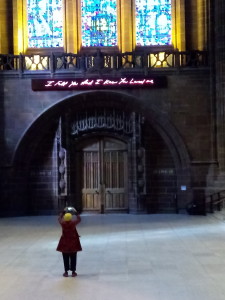Trying to keep up with all the cultural events in and around Merseyside is almost a full-time job; a dream of a job, one might say. There are highs and lows culturally, as with anywhere, but the diversity and range of exhibitions and festivals means there is always something new to discover.
One highlight was Liverpool’s free, one-night arts event, LightNight. This is an international festival when over 100 venues and organisations all over the city collaborate to create a trail of events with talks, workshops, performance, live music and more that goes on well into the night. Thankfully, the weather behaved itself and early on when the sun was out it was relaxing being able to amble about instead of hurrying along, head down, to get out of the cold. One of my sisters was visiting and our first stop was the Bombed Out Church on Leece Street, where an array of food stalls had been set up. The accompaniment to our snack was a heart-warming performance by the Liverpool Signing Choir, something we’d never seen before. It was entrancing and such an affecting coming together of deaf and hearing children and adults, using two universal languages of signing and music.
The Bombed Out Church appeals very much to my philosophy of allowing buildings and objects to reflect their history rather than “papering over the cracks”. The website dedicated to this early 19th century church, St Luke’s, explains that it was gutted during WW2 bombing and the decision was taken not to restore it but to make it safe and keep it as a place for everyone, as it had always been. Since 2007 it has been operating as a “managed ruin”, a multi-disciplinary arts venue with a programme of curated events, community engagement and creative learning projects.
A request from a visiting friend to see the city’s Anglican cathedral meant that I finally stood in front of Tracey Emin’s pink neon light  installation, I Felt You And I Knew You Loved Me. The location of the piece on the red sandstone wall above the West doors gives it space and dignity and it makes an intriguing juxtaposition with the stained glass windows above. It is an inspired response from the artist to the vast hall and an imaginative commission from the church. Its appeal for me is that the wording is ambiguous, in that it could equally be referring to a human love as a god’s.
installation, I Felt You And I Knew You Loved Me. The location of the piece on the red sandstone wall above the West doors gives it space and dignity and it makes an intriguing juxtaposition with the stained glass windows above. It is an inspired response from the artist to the vast hall and an imaginative commission from the church. Its appeal for me is that the wording is ambiguous, in that it could equally be referring to a human love as a god’s.
Antony Gormley’s, Another Place, continues to be a constant in my life with daily walks on Crosby Beach. And yet here too there is always something different to observe. I don’t just mean the effects of the tide and weather on the figures but the way people interact with them. This ranges from awe to irreverence to emulation. A gallery in Crosby is selling small, cut-out rusty metal replicas of the figures and photographs of the casts are frequently used by local businesses in advertising. One of the most amusing of these I saw recently was a removal company called “Another Place” … the slogan being “we’ll get you from one place to another”.